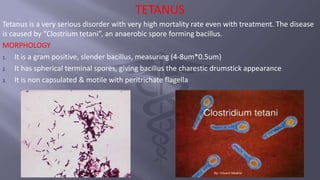Tetanus
- 1. TETANUS Tetanus is a very serious disorder with very high mortality rate even with treatment. The disease is caused by âClostrium tetaniâ, an anaerobic spore forming bacillus. MORPHOLOGY 1. It is a gram positive, slender bacillus, measuring (4-8um*0.5um) 2. It has spherical terminal spores, giving bacillus the charestic drumstick appearance 3. It is non capsulated & motile with peritrichate flagella
- 2. POSSIBLE ROUTES OF INFECTIONS 1. Umbilical cord: in neonates, seen in communities that practice cowdung application on the umbilical stump 2. Wound: as an complication of road traffic accident 3. Minor injuries with rusted nails, piercing of ear lobes, tattoing 4. Endogenous infection after septic abortions or surgical operations on gastrointestinal tract 5. Tetanus due to infection acquired in the operation threatre Thus tetanus is an wound infection â NO WOUND, NO TETANUSâ
- 3. TOXINS a. Tetanospasmin (neurotoxin): it has affinity towards nervous tissue. It reaches the central nervous system along the axons of motor nerve trunks b. Tetanolysin (haemolysin) The toxins act in the following ways:- 1. It inhibit the release of cholinesterase 2. It act at the spinal level and cause reflex contraction of muscles due to minor stimuli 3. The toxins which is fixed to the nervous tissue cannot be neutralized SIGN & SYMPTOMS Tetanus often begins with mild spasms in the jaw muscles (lockjaw). The spasms can also affect the chest, neck, back, abdominal muscles,and bottom. Sometimes the spasms affect muscles that help with breathing, which can lead to breathing problems. Prolonged muscular action causes sudden, powerful, and painful contractions of muscle groups. This is called tetany. These episodes can cause fractures and muscle tears. Other symptoms include drooling, excessive sweating, fever, hand or foot spasms, irritability, swallowing difficulty, uncontrolled urination or defecation.
- 5. SPECIAL TYPES OF TETANUS 1. Tetanus neonatrum 2. Local tetanus 3. Cephalic tetanus 4. Bulbar tetanus 5. Latent tetanus 6. Postoperative tetanus 7. Otitis tetanus DIAGNOSIS The "spatula test" is a clinical test for tetanus that involves touching the posterior pharyngeal wall with a sterile, soft-tipped instrument and observing the effect. A positive test result is the involuntary contraction of the jaw (biting down on the "spatula") and a negative test result would normally be a gag reflex attempting to expel the foreign object.
- 7. TREATMENT OF ESTABLISHED TETANUS 1. GENERAL MANAGEMENT 2. SPECIFIC MANAGEMENT GENERAL MANAGEMENT a. Admission & isolation b. Wound care: drainage of pus c. Injection tetanus toxoid: 0.5ml to be given IM d. Human anti tenanus globulin given in the dose 3000-4000 units e. Injection crystalline penicillin 10 labels unit every 6 hours is the drug of choice against clostridium tetani, given for a period of 7-10 days f. Metronidazole 500 mg IV, 8th hourly for 10 days SPECIFIC MANAGEMENT ïķ MILD CASES: there is only tonic rigidity without spasm or dysphagia. Patients are managed by heavy sedation, benzodiazepine & morphine act centrally to minimize the effects of tetanospasmin. Chlorpromazine being a receptor blocker can decrease sympathetic activity
- 8. ïķ SERIOUSLY ILL CASES 1. They have dysphagia & reflex spasms 2. A nosogastric tube is introduced for feeding purpose & to administer drugs 3. Tracheostomy, if breating difficulty arises ïķ DANGEROUSLY ILL CASES 1. This group includes patient with major cyanotic convulsions 2. In addition to sedatives, patients are paralysed with muscle relaxants and positive pressure ventilation is given till they recover PROPHYLAXIS 1. Infants & children are immunized with tetanus toxoid, diphtheria, pertussis vaccine (DPT) three doses at 6, 10, 14 weeks of age A booster dose is given at 18 months and school going time 5 yrs, & once in 5 years 2. Tetanus neonatrum can be prevented by immunization of the mother with two tetanus toxoid injection half ml IM given in the 3rd trimester of pregnancy 3. Tetanus can be prevented by giving tetanus antitoxin, 250 units
- 10. THANK YOU
- 11. ïĻ First level ïĄ Second level ïš Third level ï Fourth level ï Fifth level














